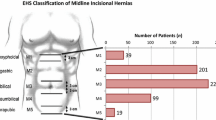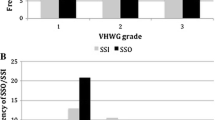Abstract
Introduction
Despite being one of the most commonly performed general surgery procedures, surgical site infection (SSI) is still seen in primary, elective, open inguinal hernia repair. Studies have reported a wide range of infection rates, yet predictive risk factors have not been definitely identified leading to variability and controversy in the use of pre-operative antibiotics. In this study, the authors seek to identify factors predictive of SSI development in a large cohort of patients undergoing initial unilateral open inguinal repair.
Methods
The American College of Surgery National Surgical Quality Improvement Program (ACS NSQIP) personal use file (PUF) database was queried for initial, open, reducible inguinal hernia repair cases in adults with clean surgical sites performed from 2012 to 2015 (CPT 49,505 and class one wound). Patient data were analyzed using univariate and multivariate analysis to identify factors predictive of surgical site infection.
Results
57,951 cases were identified. 90.8% were men with an average age of 58.2 years and a median operative time of 53.0 min. Of all variables evaluated with univariate logistic regression, 17 demonstrated an association with surgical site infection. Performing multiple logistic regression on those 17 variables yielded 3 factors independently associated with surgical site infection: diabetes (OR 2.017, 95% CI 1.012–4.023), BMI ≥ 35 kg/m2 (OR 2.587, 95% CI 1.123–5.964), and current smoking (OR 2.071, 95% CI 1.126–3.811).
Conclusion
Diabetes, BMI ≥ 35 kg/m2, and current smoking are significantly associated with an increased odds surgical site infection after initial, open, reducible inguinal hernia repair in adults with clean surgical sites.
Similar content being viewed by others
References
Everhart JE (ed) (1994) Abdominal wall hernia. National Institute of Diabetes and Digestive and Kidney Diseases, Bethesda
Abramson JH, Gofin J, Hopp C, Makler A, Epstein LM (1978) The epidemiology of inguinal hernia. A survey in western Jerusalem. J Epidemiol Community Health 32:59–67
Ruhl CE, Everhart JE (2007) Risk factors for inguinal hernia among adults in the US population. Am J Epidemiol 165:1154–1161
Zendejas B, Ramirez T, Jones T, Kuchena A, Ali SM, Hernandez-Irizarry R, Lohse CM, Farley DR (2013) Incidence of inguinal hernia repairs in Olmsted County, MN: a population-based study. Ann Surg 257:520–526
Kouhia S, Vironen J, Hakala T, Paajanen H (2015) Open mesh repair for inguinal hernia is safer than laparoscopic repair or open non-mesh repair: a nationwide registry study of complications. World J Surg 39:1878–1884
Weed HG (2003) Antimicrobial prophylaxis in the surgical patient. Med Clin N Am 87:59–75
Barie PS (2000) Modern surgical antibiotic prophylaxis and therapy—less is more. Surg Infect (Larchmt) 1:23–29
Knight R, Charbonneau P, Ratzer E, Zeren F, Haun W, Clark J (2001) Prophylactic antibiotics are not indicated in clean general surgery cases. Am J Surg 182:682–686
Sanabria A, Dominguez LC, Valdivieso E, Gomez G (2007) Prophylactic antibiotics for mesh inguinal hernioplasty: a meta-analysis. Ann Surg 245:392–396
Berard F, Gandon J (1964) Postoperative wound infections: the influence of ultraviolet irradiation of the operating room and of various other factors. Ann Surg 160:1–192
Woods RK, Dellinger EP (1998) Current guidelines for antibiotic prophylaxis of surgical wounds. Am Fam Physician 57:2731–2740
Li JF, Lai DD, Zhang XD, Zhang AM, Sun KX, Luo HG, Yu Z (2012) Meta-analysis of the effectiveness of prophylactic antibiotics in the prevention of postoperative complications after tension-free hernioplasty. Can J Surg 55:27–32
Sanchez-Manuel FJ, Lozano-Garcia J, Seco-Gil JL (2012) Antibiotic prophylaxis for hernia repair. Cochrane Database Syst Rev 2012:CD003769
Bursac Z, Gauss CH, Williams DK, Hosmer DW (2008) Purposeful selection of variables in logistic regression. Source Code Biol Med 3:17
Davenport DL, Bowe EA, Henderson WG, Khuri SF, Mentzer RM Jr (2006) National Surgical Quality Improvement Program (NSQIP) risk factors can be used to validate American Society of Anesthesiologists Physical Status Classification (ASA PS) levels. Ann Surg 243:636–641
Shoelson SE, Lee J, Goldfine AB (2006) Inflammation and insulin resistance. J Clin Investig 116:1793–1801
Saltiel AR, Olefsky JM (2017) Inflammatory mechanisms linking obesity and metabolic disease. J Clin Investig 127:1–4
Sopori M (2002) Effects of cigarette smoke on the immune system. Nat Rev Immunol 2:372–377
Hotamisligil GS (2006) Inflammation and metabolic disorders. Nature 444:860–867
Stampfli MR, Anderson GP (2009) How cigarette smoke skews immune responses to promote infection, lung disease and cancer. Nat Rev Immunol 9:377–384
Dandona P, Aljada A, Bandyopadhyay A (2004) Inflammation: the link between insulin resistance, obesity and diabetes. Trends Immunol 25:4–7
Sunyer J, Forastiere F, Pekkanen J, Plana E, Kolz M, Pistelli R, Jacquemin B, Bruske-Hohlfeld I, Pitsavos C, Bellander T, Koenig W, Peters A (2009) Interaction between smoking and the interleukin-6 gene affects systemic levels of inflammatory biomarkers. Nicotine Tob Res 11:1347–1353
Tanaka T, Narazaki M, Masuda K, Kishimoto T (2016) Regulation of IL-6 in immunity and diseases. Adv Exp Med Biol 941:79–88 (332)
Gilbert AI, Felton LL (1993) Infection in inguinal hernia repair considering biomaterials and antibiotics. Surg Gynecol Obstet 177:126–130
Lockhart K, Dunn D, Teo S et al (2018) Mesh versus non-mesh for inguinal and femoral hernia repair. Cochrane Database Syst Rev. https://doi.org/10.1002/14651858.CD011517.pub2 (Art. No.: CD011517)
Author information
Authors and Affiliations
Corresponding author
Ethics declarations
Conflict of interest
The authors declare no conflict of interest.
Ethical approval
Ethical approval was not required for the study, as it did not include the handling of any personal or confidential data.
Human and animal rights
This article does not contain any studies with human participants or animals performed by any of the authors.
Informed consent
No informed consent was required for this study.
Additional information
His co-authors dedicate this article to the Memory of Dr. Jedd Sereysky (1984–2018).
Publisher's Note
Springer Nature remains neutral with regard to jurisdictional claims in published maps and institutional affiliations.
Rights and permissions
About this article
Cite this article
Sereysky, J., Parsikia, A., Stone, M.E. et al. Predictive factors for the development of surgical site infection in adults undergoing initial open inguinal hernia repair. Hernia 24, 173–178 (2020). https://doi.org/10.1007/s10029-019-02050-3
Received:
Accepted:
Published:
Issue Date:
DOI: https://doi.org/10.1007/s10029-019-02050-3




